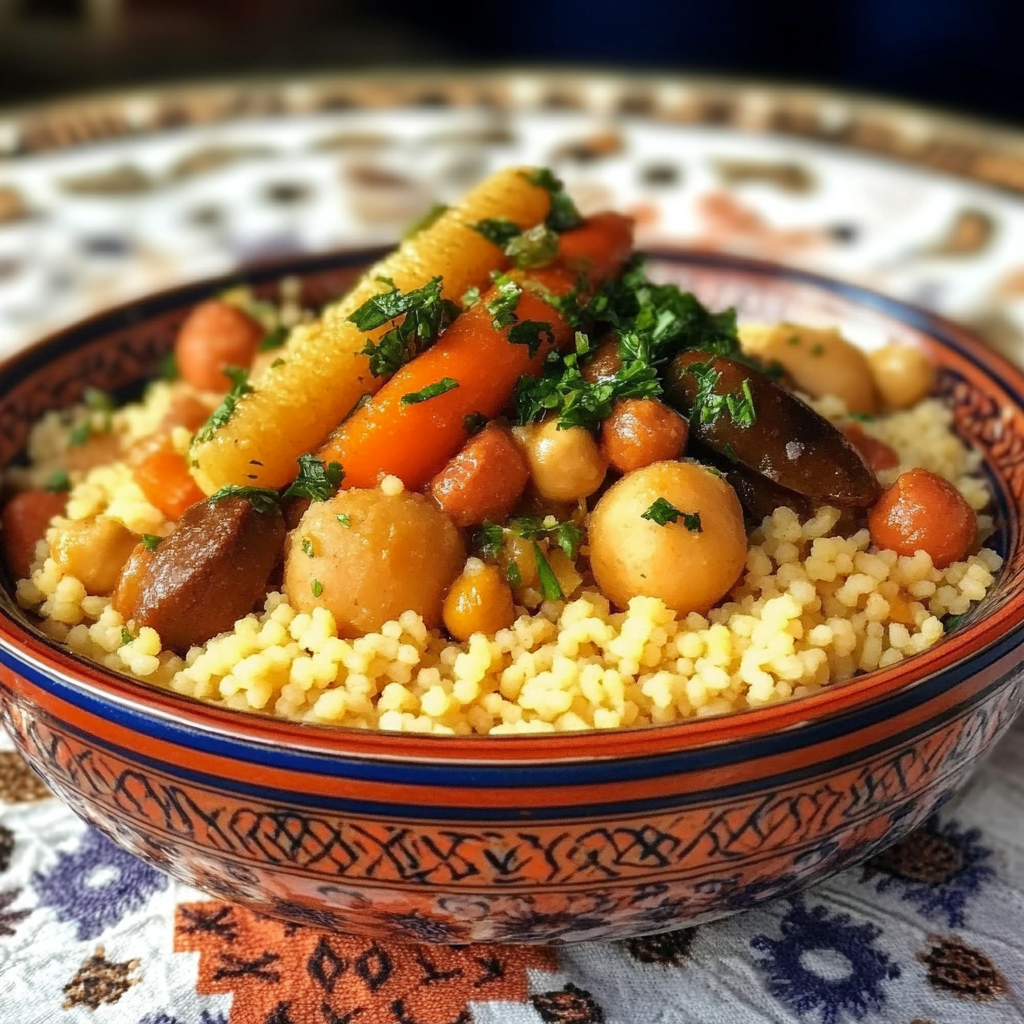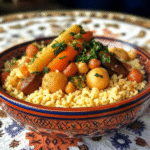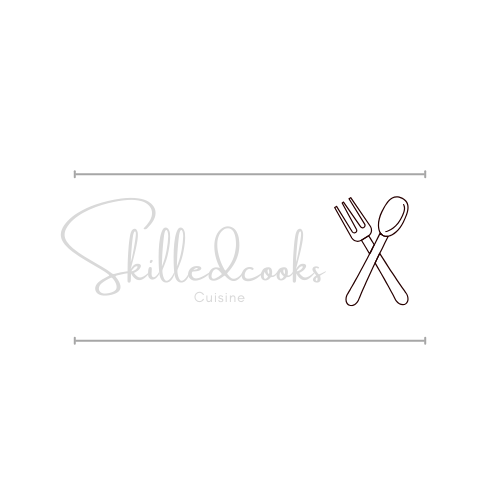🥘 Introduction to Moroccan Couscous
Few dishes capture the essence of North African cuisine quite like Moroccan couscous. This traditional staple is much more than a simple side—it’s a dish steeped in cultural heritage, communal rituals, and centuries-old culinary tradition. Typically made from semolina wheat, Moroccan couscous is steamed until light and fluffy, then served with a rich blend of spiced vegetables, meats, and sometimes sweet toppings like caramelized onions or raisins.
Often prepared for Friday gatherings and religious celebrations, couscous is a symbol of generosity and hospitality in Moroccan households. Its versatility has allowed it to evolve into modern global recipes, while still maintaining its authentic heart.
Whether served with seven vegetables, lamb, or reimagined in a stuffed vegetable recipe, like these zucchini boats, Moroccan couscous remains a flavorful gateway into the rich traditions of North African cooking.
🏺 The Origins of Moroccan Couscous
Moroccan couscous has its roots in Berber cuisine, dating back to the 11th century. Initially spread through North Africa and parts of the Mediterranean, couscous is believed to have symbolized abundance, hospitality, and celebration.
Over time, the dish evolved, adapting to local ingredients and preferences. Today, it remains a symbolic and staple food in Morocco and across the Maghreb region.
🧠 What is Moroccan Couscous?
Couscous refers to tiny granules made from semolina wheat that are traditionally steamed. While often confused with grains like quinoa or rice, couscous is actually a type of pasta.
Moroccan couscous stands out for its:
- Fine grain texture
- Multi-layered spice flavor
- Use of a traditional steamer called a couscoussier
Learn more about the history of couscous and how it became a staple of North African cuisine.
🍲 Different Types of Moroccan Couscous
There’s no single version of couscous in Morocco. Each region and household has its own unique twist, but the most popular types include:
- Couscous with Seven Vegetables: Features carrots, zucchini, pumpkin, and more.
- Tfaya Couscous: Topped with sweet caramelized onions, raisins, and cinnamon.
- Royal Couscous: Includes a mix of meats like lamb, chicken, and merguez sausage.
- Couscous Bidaoui: The Casablanca version with tender meat and fewer vegetables.
These variations highlight the versatility of couscous as both a festive and everyday dish.
Wondering whether couscous is good for you? Here’s the nutritional value of couscous, including its fiber, protein, and low-fat benefits.
🛠️ Traditional Preparation: How Couscous is Made
Making authentic Moroccan couscous is an art form. In traditional Moroccan homes, it’s steamed multiple times in a couscoussier rather than simply boiled.
Basic Steps to Prepare Traditional Couscous:
- Soak and oil the couscous to separate grains.
- Steam the couscous over simmering broth (3 rounds recommended).
- Fluff by hand between steams to ensure light texture.
- Serve with spiced broth, vegetables, and meat.
Unlike instant couscous, traditional preparation takes time and skill—but the flavor is unmatched.
🧂 Key Ingredients Used
Here are some of the essential ingredients that give Moroccan couscous its rich flavor:
- Semolina wheat (the base of couscous)
- Aromatics: onions, garlic, ginger
- Spices: turmeric, cumin, saffron, cinnamon
- Vegetables: carrots, zucchini, chickpeas, turnips
- Proteins: lamb, chicken, merguez, or vegetarian substitutes
- Sweet garnishes: raisins, caramelized onions (in Tfaya)
🧄 Flavor Profile and Texture
The result? A light and fluffy dish with:
- Earthy notes from root vegetables
- Sweetness from raisins or onions
- Warmth from spices like cinnamon and cumin
Moroccan couscous is often served with a generous ladle of brothy sauce, turning it into a full, comforting meal.

🥦 Nutritional Value and Health Benefits
CMoroccan couscous is not only delicious but also a nutrient-rich addition to your diet. Made from semolina wheat, it provides a solid base of complex carbohydrates, making it a great source of long-lasting energy.
Key Health Benefits:
- Low in fat: Naturally low in saturated fats, especially when served with vegetables.
- Rich in fiber: When paired with legumes like chickpeas and a variety of vegetables.
- Plant-based protein: Especially in vegetarian couscous recipes.
- Selenium source: A trace mineral that supports immune function and thyroid health.
- Iron content: Especially when paired with iron-rich vegetables or meat.
By using a vegetable-rich broth and adding proteins like chicken or lamb, or even tofu for vegetarians, couscous becomes a complete, balanced meal. For a colorful and nutritious pairing, try it with a vibrant cucumber bell pepper salad.
🍚 Couscous vs. Other Types
Confused about the different types of couscous? Here’s a quick comparison:
| Type | Grain Size | Texture | Cooking Method |
|---|---|---|---|
| Moroccan | Fine | Fluffy | Traditionally steamed |
| Israeli (Pearl) | Large | Chewy | Boiled |
| Lebanese (Mograbieh) | Largest | Doughy | Slow-cooked |
Each type offers a unique taste and texture, but Moroccan couscous remains the most traditional.
🍛 Popular Moroccan Couscous Recipes
There are countless ways to prepare Moroccan couscous, each reflecting local traditions and family preferences. Below are some of the most beloved and accessible recipes:
1. Couscous with Seven Vegetables
One of the most iconic versions, this dish combines carrots, zucchini, pumpkin, turnips, and chickpeas in a spiced broth. It’s a great vegetarian option, especially when served with a crisp cucumber bell pepper salad for contrast.
2. Couscous Tfaya
This sweet-savory variation is topped with caramelized onions, raisins, and a touch of cinnamon. It pairs beautifully with slow-cooked lamb or chicken, adding complexity and a festive flair.
3. Royal Couscous
A celebratory dish combining lamb shanks, chicken, and Merguez sausage. It’s often served on holidays or large family gatherings. Add a side of stuffed zucchini boats to complete the spread.
4. Couscous Salad Bowl
For a modern take, try chilled couscous mixed with lemon vinaigrette, fresh herbs, and roasted vegetables. It’s ideal for picnics or weekday lunches.
Whether you’re going traditional or modern, these couscous recipes showcase the dish’s versatility and flavor depth.
🥄 How to Serve Moroccan Couscous
Traditionally, Moroccan couscous is served on a large communal platter, symbolizing togetherness and hospitality. The couscous is carefully mounded in the center, with slow-cooked vegetables and meat or chickpeas arranged on top. A flavorful broth is either poured over or served on the side.
To enhance presentation and flavor, consider these finishing touches:
- Garnish with fresh parsley or cilantro
- Top with caramelized onions or toasted almonds
- Serve with a light stuffed vegetable recipe like zucchini boats
This setup offers both a visual feast and a soulful dining experience.nce.
Print
Moroccan couscous
- Total Time: 45 minutes
- Yield: 6 servings 1x
Description
Moroccan couscous is a fluffy semolina-based dish traditionally steamed and served with a flavorful mix of spiced vegetables, meat or chickpeas, and aromatic broth.
Ingredients
- 2 cups fine couscous (semolina)
- 1 tbsp olive oil
- 2 cups vegetable or chicken broth
- 1 tsp salt
- 1 tsp cumin
- 1 tsp turmeric
- ½ tsp cinnamon
- 2 carrots (chopped)
- 2 zucchinis (chopped)
- 1 onion (diced)
- 1 can chickpeas (drained)
- Optional: lamb or chicken (raisins, saffron)
Instructions
- Place couscous in a large bowl, drizzle with olive oil, and mix with your hands.
- Bring broth to a simmer and pour over couscous. Cover and let it absorb for 5–10 minutes.
- Fluff couscous with a fork.
- In a pan, sauté onion and spices until aromatic.
- Add chopped vegetables and chickpeas. Simmer until tender.
- Combine couscous and vegetables. Serve warm with broth ladled over top.
- Optionally, top with caramelized onions or roasted meat.
Notes
-
Fluff the couscous after steaming to prevent clumping.
-
Use homemade broth for deeper flavor.
-
For sweeter versions (Tfaya), add caramelized onions and raisins.
-
This dish pairs well with a side like cucumber bell pepper salad.
- Prep Time: 15 minutes
- Cook Time: 30 minutes
- Category: Main Course, Steamed
- Cuisine: Moroccan
Nutrition
- Calories: 290
🌍 Modern Twists and Global Variations
While Moroccan couscous has deep traditional roots, it has also inspired creative adaptations around the world. In modern kitchens, couscous appears in:
- Mediterranean grain bowls with grilled chicken or tofu
- Couscous-stuffed bell peppers or eggplant
- Cold couscous salads with lemon, herbs, and feta
- Served with sauces like lemon vinaigrette or spicy yogurt drizzle
These global variations maintain the dish’s fluffy texture and nutritional value, while adapting it to a range of cuisines. For example, pair it with a vibrant street corn chicken rice bowl for a modern fusion.
👩🍳 Cooking Tips for Beginners
IfMaking Moroccan couscous at home can be simple with a few helpful tips:
- Use high-quality semolina couscous for the best texture.
- Steam it multiple times (traditionally three) for fluffiness, instead of boiling.
- Fluff the grains between steamings using a fork or your hands.
- Add a drizzle of olive oil or butter to keep it from clumping.
- Use broth instead of water to infuse more flavor.
- Avoid over-soaking; couscous cooks quickly once steamed.
These basics will help you master a traditional Moroccan dish with ease.
FAQs About Moroccan Couscous ❓
What makes Moroccan couscous different?
Moroccan couscous uses fine semolina granules and is traditionally steamed three times, resulting in a light, fluffy texture. Unlike larger varieties like Israeli or Lebanese couscous, it absorbs flavors more delicately.
Can Moroccan couscous be made vegetarian?
Yes! It’s often served as a vegetarian dish, especially during fasting days. Try pairing it with root vegetables or a refreshing vegetable side dish like cucumber bell pepper salad.
What is traditionally served with couscous?
Common pairings include slow-cooked lamb, chicken with spices, and steamed vegetables. Sweet toppings like tfaya (caramelized onions with raisins) are also traditional.
How is couscous eaten in Morocco?
Typically served on large communal platters, Moroccan couscous is often enjoyed by hand, symbolizing family unity and blessing—especially on Fridays and special occasions.
🏁 Conclusion
Moroccan couscous is more than just a side dish—it’s a story of culture, community, and culinary craftsmanship. From its historical roots to its modern-day adaptations, couscous continues to nourish and inspire.
Whether you’re trying the traditional seven vegetable version or experimenting with a modern couscous bowl, this iconic dish invites you to experience Morocco—one bite at a time.



